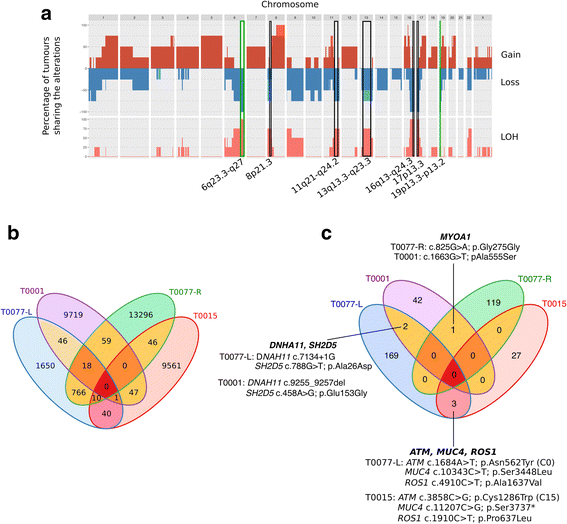Morphology and genomic hallmarks of breast tumours developed by ATM deleterious variant carriers
- PMID: 29665859
- PMCID: PMC5905168
- DOI: 10.1186/s13058-018-0951-9
Morphology and genomic hallmarks of breast tumours developed by ATM deleterious variant carriers
Abstract
Background: The ataxia telangiectasia mutated (ATM) gene is a moderate-risk breast cancer susceptibility gene; germline loss-of-function variants are found in up to 3% of hereditary breast and ovarian cancer (HBOC) families who undergo genetic testing. So far, no clear histopathological and molecular features of breast tumours occurring in ATM deleterious variant carriers have been described, but identification of an ATM-associated tumour signature may help in patient management.
Methods: To characterise hallmarks of ATM-associated tumours, we performed systematic pathology review of tumours from 21 participants from ataxia-telangiectasia families and 18 participants from HBOC families, as well as copy number profiling on a subset of 23 tumours. Morphology of ATM-associated tumours was compared with that of 599 patients with no BRCA1 and BRCA2 mutations from a hospital-based series, as well as with data from The Cancer Genome Atlas. Absolute copy number and loss of heterozygosity (LOH) profiles were obtained from the OncoScan SNP array. In addition, we performed whole-genome sequencing on four tumours from ATM loss-of-function variant carriers with available frozen material.
Results: We found that ATM-associated tumours belong mostly to the luminal B subtype, are tetraploid and show LOH at the ATM locus at 11q22-23. Unlike tumours in which BRCA1 or BRCA2 is inactivated, tumours arising in ATM deleterious variant carriers are not associated with increased large-scale genomic instability as measured by the large-scale state transitions signature. Losses at 13q14.11-q14.3, 17p13.2-p12, 21p11.2-p11.1 and 22q11.23 were observed. Somatic alterations at these loci may therefore represent biomarkers for ATM testing and harbour driver mutations in potentially 'druggable' genes that would allow patients to be directed towards tailored therapeutic strategies.
Conclusions: Although ATM is involved in the DNA damage response, ATM-associated tumours are distinct from BRCA1-associated tumours in terms of morphological characteristics and genomic alterations, and they are also distinguishable from sporadic breast tumours, thus opening up the possibility to identify ATM variant carriers outside the ataxia-telangiectasia disorder and direct them towards effective cancer risk management and therapeutic strategies.
Keywords: ATM; Breast tumour; Copy number; Genetic instability; Genomic signature; Loss of heterozygosity; OncoScan array; Pathology.
Conflict of interest statement
Ethics approval and consent to participate
Written informed consent for genetic studies and use of medical records for the present analyses was obtained from all participants enrolled in the Retro-AT, CoF-AT, GENESIS and kConFab research programs. The appropriate local ethics committee (Comité de Protection des Personnes [CCP] Ile-de-France III 2002/2006) and the French data protection authority (Commission Nationale de l’Informatique et des Libertés [CNIL]) approved the individual resource collections; Retro-AT, CoF-AT, and GENESIS study protocols; and the specific study on tumour material of
Consent for publication
Not applicable.
Competing interests
The authors declare that they have no competing interests.
Publisher’s Note
Springer Nature remains neutral with regard to jurisdictional claims in published maps and institutional affiliations.
Figures



References
-
- Micol R, Ben Slama L, Suarez F, Le Mignot L, Beaute J, Mahlaoui N, Dubois d’Enghien C, Lauge A, Hall J, Couturier J, et al. Morbidity and mortality from ataxia-telangiectasia are associated with ATM genotype. J Allergy Clin Immunol. 2011;128(2):382–9.e1. doi: 10.1016/j.jaci.2011.03.052. - DOI - PubMed
-
- Suarez F, Mahlaoui N, Canioni D, Andriamanga C, Dubois d’Enghien C, Brousse N, Jais JP, Fischer A, Hermine O, Stoppa-Lyonnet D. Incidence, presentation, and prognosis of malignancies in ataxia-telangiectasia: a report from the French national registry of primary immune deficiencies. J Clin Oncol. 2015;33(2):202–208. doi: 10.1200/JCO.2014.56.5101. - DOI - PubMed
-
- Taylor AM, Metcalfe JA, Thick J, Mak YF. Leukemia and lymphoma in ataxia telangiectasia. Blood. 1996;87(2):423–438. - PubMed
Publication types
MeSH terms
Substances
LinkOut - more resources
Full Text Sources
Other Literature Sources
Medical
Molecular Biology Databases
Research Materials
Miscellaneous

